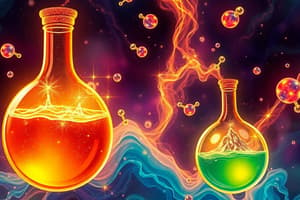Podcast
Questions and Answers
What type of reaction occurs when aliphatic and aromatic primary and secondary amines react with acid chlorides, anhydrides, and esters?
What type of reaction occurs when aliphatic and aromatic primary and secondary amines react with acid chlorides, anhydrides, and esters?
- Electrophilic addition
- Nucleophilic substitution (correct)
- Radical polymerization
- Oxidation
In acylation reactions, what is the role of the base (e.g., pyridine) that is stronger than the amine?
In acylation reactions, what is the role of the base (e.g., pyridine) that is stronger than the amine?
- Acts as a catalyst
- Increases the reaction temperature
- Removes the HCl formed (correct)
- Forms a byproduct
What are the products obtained by acylation reactions involving amines?
What are the products obtained by acylation reactions involving amines?
- Amides (correct)
- Alcohols
- Carboxylic acids
- Ketones
What is the name of the reaction when amines react with benzoyl chloride (C6H5COCl)?
What is the name of the reaction when amines react with benzoyl chloride (C6H5COCl)?
How do amines react with carboxylic acids at room temperature?
How do amines react with carboxylic acids at room temperature?
Study Notes
Acylation Reactions Involving Amines
- Aliphatic and aromatic primary and secondary amines react with acid chlorides, anhydrides, and esters to form amides.
- In acylation reactions, a strong base (e.g., pyridine) is used to facilitate the reaction by removing the HCl formed during the reaction.
- The products of acylation reactions involving amines are amides.
- The reaction between amines and benzoyl chloride (C6H5COCl) is known as the Schotten-Baumann reaction.
- At room temperature, amines react with carboxylic acids to form salts.
Studying That Suits You
Use AI to generate personalized quizzes and flashcards to suit your learning preferences.
Description
Explore how aliphatic and aromatic primary and secondary amines react with acid chlorides, anhydrides, and esters through nucleophilic substitution to form amides in the acylation reaction. Understand the mechanism involving the replacement of hydrogen atoms by acyl groups. Learn about the role of pyridine as a base in shifting the equilibrium of the reaction.



